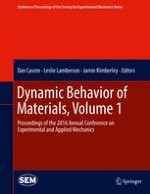2017 | OriginalPaper | Buchkapitel
36. Failure Processes Governing High Rate Impact Resistance of Epoxy Resins Filled with Core Shell Rubber Nanoparticles
verfasst von : Erich D. Bain, Daniel B. Knorr Jr., Adam D. Richardson, Kevin A. Masser, Jian Yu, Joseph L. Lenhart
Erschienen in: Dynamic Behavior of Materials, Volume 1
Aktivieren Sie unsere intelligente Suche, um passende Fachinhalte oder Patente zu finden.
Wählen Sie Textabschnitte aus um mit Künstlicher Intelligenz passenden Patente zu finden. powered by
Markieren Sie Textabschnitte, um KI-gestützt weitere passende Inhalte zu finden. powered by
